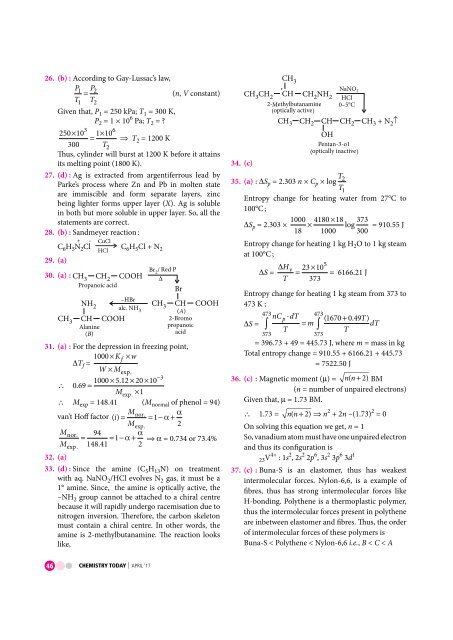Chemistry_Today_April_2017_vk_com_stopthepress
You also want an ePaper? Increase the reach of your titles
YUMPU automatically turns print PDFs into web optimized ePapers that Google loves.
26. (b) : According to Gay-Lussac’s law,<br />
P1<br />
P<br />
= 2<br />
(n, V constant)<br />
T1<br />
T2<br />
Given that, P 1 = 250 kPa; T 1 = 300 K,<br />
P 2 = 1 × 10 6 Pa; T 2 = ?<br />
3 6<br />
250×<br />
10 1 10<br />
= × ⇒ T 2 = 1200 K<br />
300 T2<br />
Thus, cylinder will burst at 1200 K before it attains<br />
its melting point (1800 K).<br />
27. (d) : Ag is extracted from argentiferrous lead by<br />
Parke’s process where Zn and Pb in molten state<br />
are immiscible and form separate layers, zinc<br />
being lighter forms upper layer (X). Ag is soluble<br />
in both but more soluble in upper layer. So, all the<br />
statements are correct.<br />
28. (b) : Sandmeyer reaction :<br />
C 6 H 5 N + 2Cl – CuCl<br />
C 6 H 5 Cl + N 2<br />
29. (a)<br />
30. (a) :<br />
HCl<br />
Propanoic acid<br />
31. (a) : For the depression in freezing point,<br />
∆T f = 1000× Kf<br />
× w<br />
W×<br />
Mexp.<br />
−3<br />
1000 × 512 . × 20×<br />
10<br />
∴ 069 . =<br />
M exp. × 1<br />
∴ M exp = 148.41 (M normal of phenol = 94)<br />
M<br />
van’t Hoff factor<br />
nor.<br />
() i = = 1− α +<br />
α<br />
Mexp.<br />
2<br />
Mnor.<br />
94<br />
= = − +<br />
Mexp. 148.<br />
41 1 α α ⇒ α = 0.734 or 73.4%<br />
2<br />
32. (a)<br />
33. (d) : Since the amine (C 5 H 13 N) on treatment<br />
with aq. NaNO 2 /HCl evolves N 2 gas, it must be a<br />
1° amine. Since, the amine is optically active, the<br />
–NH 2 group cannot be attached to a chiral centre<br />
because it will rapidly undergo racemisation due to<br />
nitrogen inversion. Therefore, the carbon skeleton<br />
must contain a chiral centre. In other words, the<br />
amine is 2-methylbutanamine. The reaction looks<br />
like,<br />
34. (c)<br />
35. (a) : ∆S p = 2.303 n × C p × log T 2<br />
T1<br />
Entropy change for heating water from 27°C to<br />
100°C ;<br />
∆S p = 2.303 × 1000 4180 × 18 373<br />
× log = 910.55 J<br />
18 1000 300<br />
Entropy change for heating 1 kg H 2 O to 1 kg steam<br />
at 100°C ;<br />
∆S = ∆Hv 5<br />
23 × 10<br />
= = 6166.21 J<br />
T 373<br />
Entropy change for heating 1 kg steam from 373 to<br />
473 K ;<br />
473nCp dT<br />
T<br />
∆S =<br />
⋅ 473 ( 1670 + 049 . )<br />
∫ = m<br />
dT<br />
T<br />
∫<br />
T<br />
373<br />
373<br />
= 396.73 + 49 = 445.73 J, where m = mass in kg<br />
Total entropy change = 910.55 + 6166.21 + 445.73<br />
= 7522.50 J<br />
36. (c) : Magnetic moment (µ) = nn ( + 2)<br />
BM<br />
(n = number of unpaired electrons)<br />
Given that, µ = 1.73 BM.<br />
∴ 1.73 = nn ( + 2)<br />
⇒ n 2 + 2n –(1.73) 2 = 0<br />
On solving this equation we get, n = 1<br />
So, vanadium atom must have one unpaired electron<br />
and thus its configuration is<br />
23V 4+ : 1s 2 , 2s 2 2p 6 , 3s 2 3p 6 3d 1<br />
37. (c) : Buna-S is an elastomer, thus has weakest<br />
intermolecular forces. Nylon-6,6, is a example of<br />
fibres, thus has strong intermolecular forces like<br />
H-bonding. Polythene is a thermoplastic polymer,<br />
thus the intermolecular forces present in polythene<br />
are inbetween elastomer and fibres. Thus, the order<br />
of intermolecular forces of these polymers is<br />
Buna-S < Polythene < Nylon-6,6 i.e., B < C < A<br />
46 CHEMISTRY TODAY | APRIL ‘17


